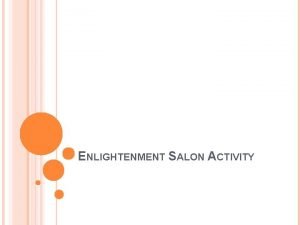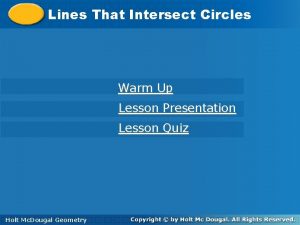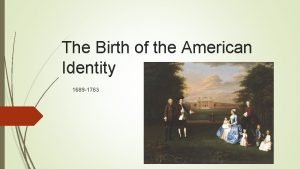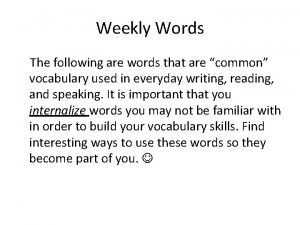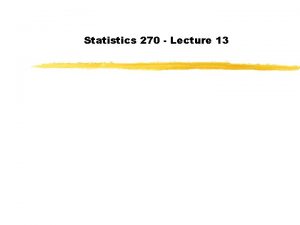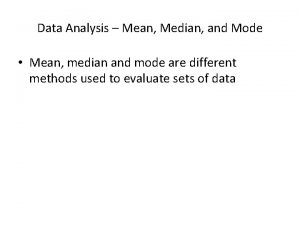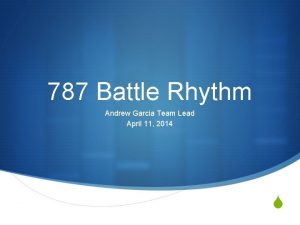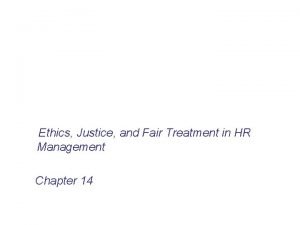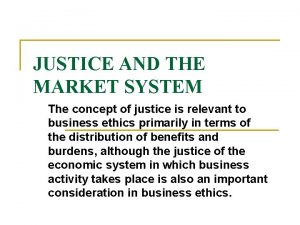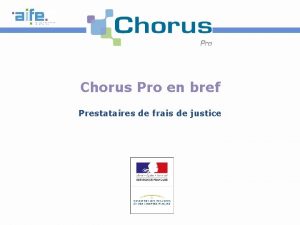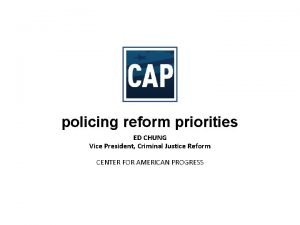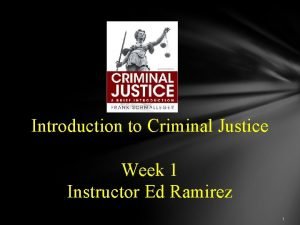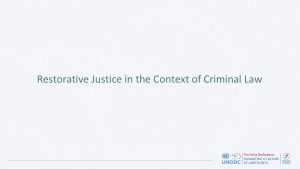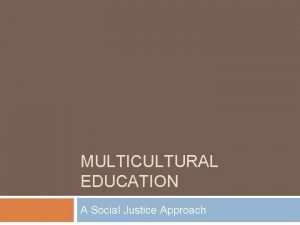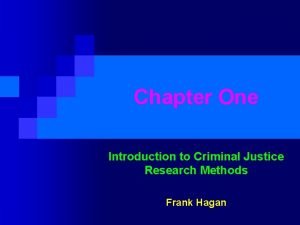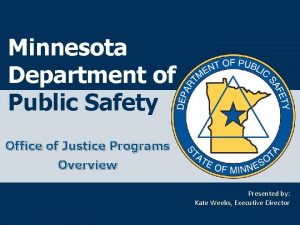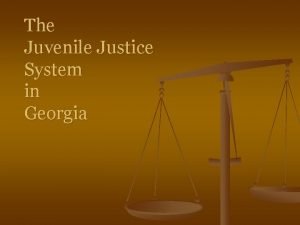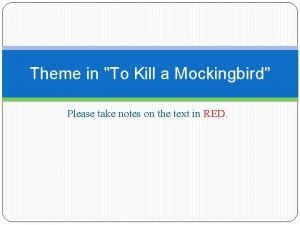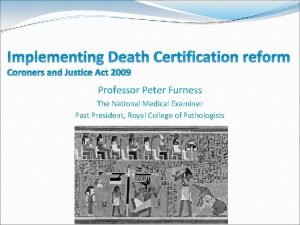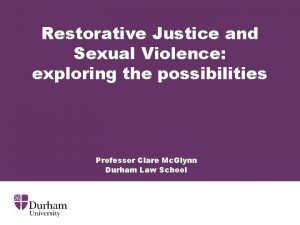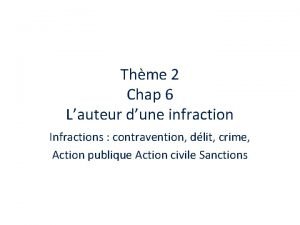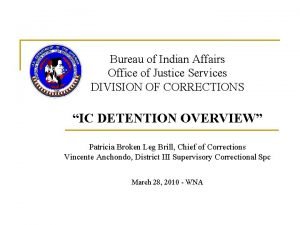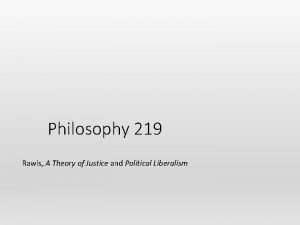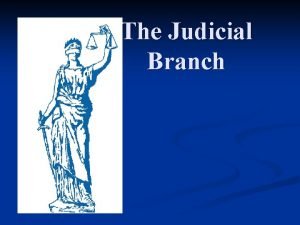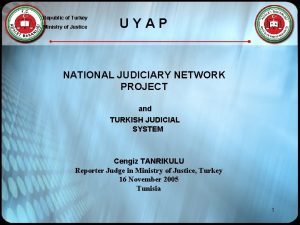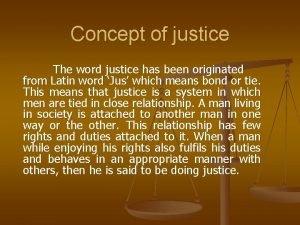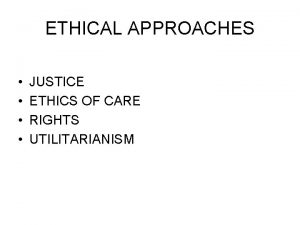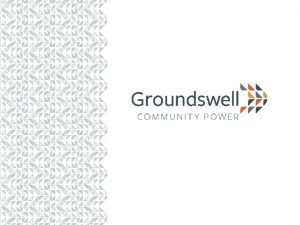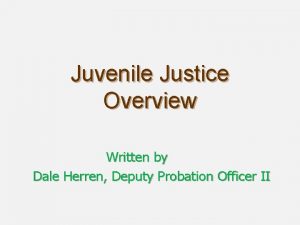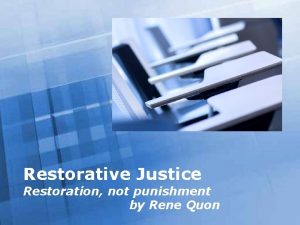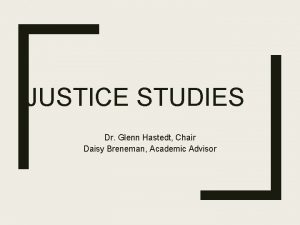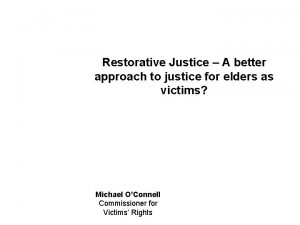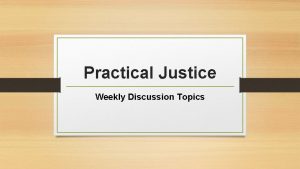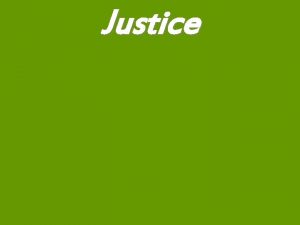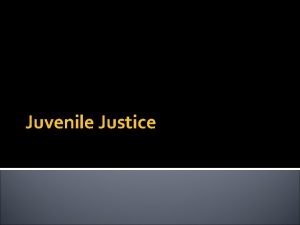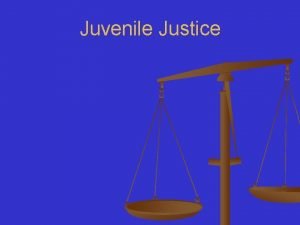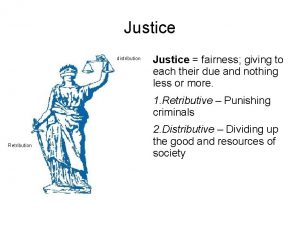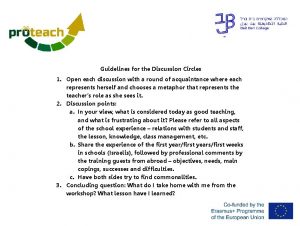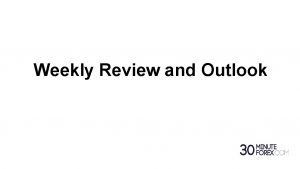Practical Justice Weekly Discussion Topics Discussion Guidelines Each











































































- Slides: 75

Practical Justice Weekly Discussion Topics

Discussion Guidelines • Each Thursday in the week during the semester we will discuss a current legal topic facing our nation currently. • Students will be required to prepare in advance for the discussion. • Each student will turn in a 1 pg. hand written or 1 pg. typed discussion outline. • Each student will also be expected to actively participate in the discussion during class.

Discussion Grade = 10 pts Discussion Outline = 5 pts • 5 bullet points supporting your opinion on the topic. • A 6 sentence paragraph providing your opinion and 3 supporting reasons to defend your opinion. Class Discussion = 5 pts • 5/5 - Actively participates and adds several points to the discussion • 3/5 – Occasionally participates • 0/5 - Does not participate in discussion

Week 1. Pennsylvania Gun Control • What are you current beliefs on Pennsylvania's gun control laws. Are they too strict or too lenient in your opinion? Be able to support your opinion.

Week 1 Discussion- Background • The United States has 88. 8 guns per 100 people, or about 270, 000 guns, which is the highest total and per capita number in the world. 22% of Americans own one or more guns (35% of men and 12% of women). America's pervasive gun culture stems in part from its colonial history, revolutionary roots, frontier expansion, and the Second Amendment, which states: "A well regulated militia, being necessary to the security of a free State, the right of the people to keep and bear Arms, shall not be infringed. " PROPONENETS of more gun control laws state that the Second Amendment was intended for militias; that gun violence would be reduced; that gun restrictions have always existed; and that a majority of Americans, including gun owners, support new gun restrictions. OPPONENETS say that the Second Amendment protects an individual’s right to own guns; that guns are needed for self-defense from threats ranging from local criminals to foreign invaders; and that gun ownership deters crime rather than causes more crime.

Code Section Tit. 18 - 908 6105, 6110. 1, 6111 Illegal Arms 1. Machine gun 2. Sawed-off shotgun 3. Firearm specially made or adopted for concealment or silent discharge 4. Altered manufacturer's number Waiting Period 48 hrs. for Hand Guns – Instant background Check for all others (Federal Fire Arms Application 1. Convicted of felony, crime of violence; 2. No delivery to persons under 18 yrs. 3. If you have reason to believe convicted of crime of violence; drug addict; habitual drunkard; unsound mind 4. Fugitive from justice (Felony Conviction) 5. Incompetent 6. Illegal Alien 7. Convicted of DUI on 3 separate occasions within a 5 -year period; 8. Subject of an active protection from abuse order. Who May Not Own Law Prohibiting Firearms On or Near Misdemeanor.




Week 2. Federal Minimum Wage • The current mandated minimum wage according to the Federal Government is $7. 25 per hour. Do you think the wage should stay the same or be raised? Support your opinion.

Week 2 Discussion- Background • The federal minimum wage was introduced in 1938 during the Great Depression under President Franklin Delano Roosevelt. It was initially set at $0. 25 per hour and has been increased by Congress 22 times, most recently in 2009 when it went from $6. 55 to $7. 25 an hour. 29 states plus the District of Columbia (DC) have a minimum wage higher than the federal minimum wage. 2, 561, 000 workers (or 3. 3% of the hourly paid working population) earn the federal minimum wage or below. PROPONENETS of a higher minimum wage state that the current federal minimum wage of $7. 25 per hour is too low for anyone to live on; that a higher minimum wage will help create jobs and grow the economy; that the declining value of the minimum wage is one of the primary causes of wage inequality between low- and middle-income workers; and that a majority of Americans, including a slim majority of self-described conservatives, support increasing the minimum wage. OPPONENETS say that many businesses cannot afford to pay their workers more, and will be forced to close, lay off workers, or reduce hiring; that increases have been shown to make it more difficult for low-skilled workers with little or no work experience to find jobs or become upwardly mobile; and that raising the minimum wage at the federal level does not take into account regional cost-of-living variations where raising the minimum wage could hurt low-income communities in particular.




Week 3. Legal Drinking Age • Should the legal drinking age of 21 in the United States be raised, lowered or stay the same? Support your opinion.

Week 3 Discussion - Background • All 50 US states have set their minimum drinking age to 21 although exceptions do exist on a state-by-state basis for consumption at home, under adult supervision, for medical necessity, and other reasons. PROPONENTS of lowering the minimum legal drinking age (MLDA) from 21 argue that it has not stopped teen drinking, and has instead pushed underage binge drinking into private and less controlled environments, leading to more health and life-endangering behavior by teens. OPPONETS of lowering the MLDA argue that teens have not yet reached an age where they can handle alcohol responsibly, and thus are more likely to harm or even kill themselves and others by drinking prior to 21. They contend that traffic fatalities decreased when the MLDA increased.







Week 4. State Marijuana Laws • Should the medical/recreational use of marijuana be permitted in the United States? Support your opinion?

Week 4. Discussion Background • In 1970, the US Congress placed marijuana in Schedule I of the Controlled Substances Act because they considered it to have "no accepted medical use. " Since then, 29 of 50 US states and DC have legalized the medical use of marijuana. PROPONETS of medical marijuana argue that it can be a safe and effective treatment for the symptoms of cancer, AIDS, multiple sclerosis, pain, glaucoma, epilepsy, and other conditions. They cite dozens of peer-reviewed studies, prominent medical organizations, major government reports, and the use of marijuana as medicine throughout world history. OPPONESNTS of medical marijuana argue that it is too dangerous to use, lacks FDAapproval, and that various legal drugs make marijuana use unnecessary. They say marijuana is addictive, leads to harder drug use, interferes with fertility, impairs driving ability, and injures the lungs, immune system, and brain. They say that medical marijuana is a front for drug legalization and recreational use.

Code Section Tit. 35 § 780 -101, et seq. Possession Under 30 g. : misdemeanor, 30 days and/or $500; Over 30 g. : misdemeanor, 1 yr. and/or $5000 Subsequent offense over 30 g. : 3 yrs. and/or $25, 000 Sale Over 1000 lbs. : felony, up to 10 yrs. and/or $100, 000 or enough to recoup drug profit; Subsequent offense or sale to minor: double penalties Trafficking


Week 5. Driving Age • Should age 16 be the state mandated legal driving age in Pennsylvania ? Support your opinion? .


Week 6. School Dress Code • Should Moon High School have a school dress code? Support your opinion? Do school dress codes violate your 1 st amendment rights?

Famous cases involving dress code • Gardner v. Cumberland School Committee, “it presents a clear and present danger to the student’s health and safety, causes an interference with school work, or creates a classroom or school disorder. ” • Tinker v. Des Moines, U. S. Supreme Court ruled that students had a constitutional right to wear a black armband to school to protest U. S. involvement in the Vietnam War. Since then, courts have continued to hold that students generally have a right to express political and religious views through their clothing. This can include, for example, wearing clothing that endorses or criticizes a political. • Under the Tinker test, schools may prohibit certain items of clothing if it can be shown that wearing them is disruptive to the school environment or creates discipline problems. Recently, certain colors, gang insignias, some sports logos, or displays of profanity on clothes have been banned. Generally, if a school′s dress code promotes discipline or good health, it will survive a legal challenge

• Guiles v. Marineau, the U. S. Court of Appeals for the Second Circuit held that the First and Fourteenth Amendments to the Constitution of the United States protect the right of a student in the public schools to wear a shirt insulting the President of the United States • ACLU v. R. H School District In the 1970’s, a federal appeals court that has jurisdiction over Rhode Island ruled in favor of a student who had been suspended for violating a school rule banning long hair on boys; one could argue that the same rights apply to students who dye their hair. On the other hand, removable body piercings may be held to not fall within the realm of constitutionally protected expression at school.

• October, 2007 the Louisiana town of Port Allen banned saggy pants in public. They joined seven other Louisiana communities in prohibiting this style. The law requires pants to be secured at the waist, and not fall below the hips or expose underwear. Violators will be fined $25 to $250. In July, 2011, the town of Hampton, Georgia passed a law imposing a $50. 00 fine for wearing saggy pants. • On the other hand, a Florida federal court ruled on May 13, 2008 that a school district was prohibited from punishing students for expressing support for gay rights. Ponce de Leon High School student, Heather Gillman and others, wore T-shirts with such slogans as “I support gays” and “Gay? Fine by me? • HARPER V. POWAY February, 2008 a California federal court upheld the hate speech policy of Poway Unified School District. In 2004, Tyler Harper wore a T-shirt to school that read on the front “I Will Not Accept What God Has Condemned” and “Homosexuality is Shameful, The court ruled that the shirt infringed upon other students’ rights more than removing it infringed on Tyler’s

Week 7. Capital Punishment • Should capital punishment be permitted in the United States? Support your opinion.

Week 7 Discussion -Background • 1, 436 people were executed in the United States from 1977 through May 2016, primarily by means of lethal injection. Most death penalty cases involve the execution of murderers although capital punishment can also be applied for treason, espionage, and other crimes. PROPOENNETS of the death penalty say it is an important tool for preserving law and order, deters crime, and costs less than life imprisonment. They argue that retribution or "an eye for an eye" honors the victim, helps console grieving families, and ensures that the perpetrators of heinous crimes never have an opportunity to cause future tragedy. OPPONENETS of capital punishment say it has no deterrent effect on crime, wrongly gives governments the power to take human life, and perpetuates social injustices by disproportionately targeting people of color (racist) and people who cannot afford good attorneys (classist). They say lifetime jail sentences are a more severe and less expensive punishment than death.



Week 8. Abortion • Should legal abortion be permitted in the United States? Support your opinion?

Week 8 Discussion - Background The debate over whether or not abortion should be a legal option continues to divide Americans long after the US Supreme Court’s 7 -2 decision on Roe v. Wade declared the procedure a "fundamental right" on Jan. 22, 1973. PROPONENTS , identifying themselves as pro-choice, contend that choosing abortion is a woman's right that should not be limited by governmental or religious authority, and which outweighs any right claimed for an embryo or fetus. They say that pregnant women will resort to unsafe illegal abortions if there is no legal option. OPPONENETS, identifying themselves as pro-life, contend that individual human life begins at fertilization, and therefore abortion is the immoral killing of an innocent human being. They say abortion inflicts suffering on the unborn child, and that it is unfair to allow abortion when couples who cannot biologically conceive are waiting to adopt.

Pennsylvania's Law of Abortion • 1. )Failure to obtain informed consent of woman; (2) failure to meet standards for legal abortion; (3) using any means to cause the death of an unborn child but not meaning use of intrauterine device or the birth control pill; (4) solely for the reason of the child's sex; (5) without making diagnosis of gestational age; (6) use of public funds, facilities, or officials • Failing to adequately care for viable fetus, M. D. violating medical consultation provisions, finding abortion necessary, violation of 2 nd M. D. requirement: Felony in 3 rd degree and license may be revoked; person inducing abortion in violation of consent standards: 1 st offense: summary offense; 2 nd and subsequent offenses: 3 rd degree misdemeanor; violation of informed consent or spousal notification provisions (spousal consent found unconstitutional in Planned Parenthood of Southeastern Pennsylvania v. Casey, but remain in Pennsylvania's statue nonetheless): guilty of "unprofessional conduct" and license may be revoked; violation of gestational age determination requirement: 3 mos. suspension of license and if falsification of records, misdemeanor in the 3 rd degree • Except for medical emergency, physician must give information to mother at least 24 hours before abortion; if mother under 18 years and not emancipated, both mother's and one parent/guardian's informed consent required-court may authorize M. D. to perform abortion. If the woman is married, she must provide signed statement that she has notified her spouse of the abortion (Spousal consent found unconstitutional in Planned Parenthood of Southeastern Pennsylvania V. Casey, but remain in PA's statute nonetheless

Week 9. “Stand Your Ground Laws” • To what extend does a citizen have the right of “self defense” in public and in ones own home or property? Support your opinion.

Pennsylvania's Self Defense Law • The Pennsylvania stand-your-ground law allows a person to use deadly force against an assailant as long as all of the following circumstances apply: 1) the actor is not engaged in illegal activity, 2) the actor is not in illegal possession of a firearm, 3) the actor has a right to be in the place where he was attacked, 4) the actor believes it is immediately necessary to use deadly force in order to protect himself from death, serious bodily injury, kidnapping or rape, and 5) the person against whom the deadly force is employed is armed with either a firearm, a realistic replica firearm or any other lethal weapon.



Week 10 -Euthanasia Law • Should physician assisted suicide be permitted in the Unites States? Support your opinion.

Week 10 – Discussion Background • PROPONENETS of euthanasia and physician-assisted suicide (PAS) contend that terminally ill people should have the right to end their suffering with a quick, dignified, and compassionate death. They argue that the right to die is protected by the same constitutional safeguards that guarantee such rights as marriage, procreation, and the refusal or termination of life-saving medical treatment. OPPONENETS of euthanasia and physician-assisted suicide contend that doctors have a moral responsibility to keep their patients alive as reflected by the Hippocratic Oath. They argue there may be a "slippery slope" from euthanasia to murder, and that legalizing euthanasia will unfairly target the poor and disabled and create incentives for insurance companies to terminate lives in order to save money.


Week 11. Restrictions on Freedom of Speech • Are the rights of Americans to speak freely and express themselves too restricted or too unrestricted by current laws? Are the rights of students in school too restricted?

Freedom of speech exceptions • • • Pornography Obscenity “Fighting words” Defamation (libel or slander) Incitement of a disturbance of peace immanent violent action (Clear and Present danger) • Defamation: is the communication of a false statement that harms the reputation of: an individual person, business, product, group, government, religion, or nation.

Famous cases dealing with freedom of speech • Texas V. Johnson – Burning of American flag. • Schenck v. United States (1919) Freedom of speech can be limited during wartime. • Gitlow V. New York - Gitlow, a socialist, was arrested in 1919 for distributing a “Left Wing Manifesto" that called for the establishment of socialism through strikes. • Tinker V. Des Moines – Students expelled for protesting Vietnam War. • Cohen V. California – Man arrested for wearing vulgar t-shirt protesting Vietnam draft. • Morse V. Fredrick – Student expelled for holding inappropriate sign at school




Week 12. - Search and Seizure • Do the current protections of privacy according to the 4 th amendment of the Constitution do enough to protect Americans from government injustice. Or does the way the laws are currently stated create barriers for law enforcements and opportunities for criminals to exploit the legal system?

Things to Consider • Do you have the same rights at school? • While you don’t shed your Constitutional rights when you go to school, they must be balanced with the rights of your classmates, as well as the responsibility of the school to provide a safe environment and a quality education. • Consider these questions as you study the case histories that follow: • Am I protected from unreasonable search and seizure at school? • Does the school need probable cause to search me or my belongings? Does the school need a warrant? • What can my school search, and when?

Probable Cause • Probable Cause – There must be enough evidence that a reasonable person would believe a crime was committed. This evidence is presented to a judge who must agree before authorizing the search by granting a warrant.

Famous Cases • Mapp V. Ohio – Police use fake warrant to obtain obscene material • Terry V. Ohio – Police conduct “pat down” search of suspicious persons • New Jersey V. T. L. O – School district searches student property for cigarettes • Riley V. California – Illegal search of cell phone • Stafford School District V. Redding – Search of a student under garments • Verona School District V. Acton – School random drug tests

Week 13. - Do we have too many frivolous law suits when it comes to civil law? • Arguments have been made that many people try to take advantage of frivolous law suits to make easy money. Others feel the ability to sue a large corporation or company needs to be in place to protect the consumer from large corporations.

Famous frivolous law suit claims • A bank robber gets shot after pointing a gun at deputy; sues city for medical bills. • An 8 -year-old New York boy is sued by his aunt for a “careless” hug. • A Florida woman is suing Fed. Ex for tripping over a package left at her doorstep. • • A women is suing Mc. Donalds for spilling hot coffee on herself. A man is suing a dry cleaning store for 68 million for losing a pair of his pants. A man sues Nike after being hit with a shoe. A women sues a department store for being tripped by a kid running in the store. It was her own kid.

Examples of Protecting the Consumer • Sketchers Shoes created a shoe that claimed to help burn more calories when walking. This was proven false, and sketchers had to settle for a $40 million suit. • Remington Fire Arms was sued when a malfunction in one of their gun models caused it to fire accidentally killing several people who purchased the product. The company was forced into bankruptcy after the case went to court. • Ford Motor Cars was sued for creating a compact car that did not meet national safety standards and was the cause of several fatal car accidents. They settled for an undisclosed amount. • Chi’s restaurant in the Beaver Valley Mall where sued in a class action law suit for 800, 000 in damages for serving food containing hepatitis A to over 9, 000 customers.

Week 14 - Prison Population • Some Americans argue that our prison populations are over crowded today. This is costing tax payers unreasonable amounts of money. These individuals feel our prison system in doing very little to effectively rehabilitate our nations prisoners. Others feel we have become too lenient on crime and need harsher punishments to deter crime. How do you feel? Support your opinion.


Ranking Title Prison Population Total 1 United States of America 2 217 947 2 China 1 649 804 3 Russian Federation 645 350 4 Brazil 622 202 5 India 418 536 6 Thailand 297 829 7 Mexico 247 001 8 Iran 225 624 9 Turkey 187 609 10 Indonesia 180 347 11 South Africa 159 563 12 Philippines 142 168 13 Vietnam 136 245 14 Colombia 120 721 15 Ethiopia 111 050

Highest Prison Population Per 100, 000 Population Ranking Title Prison Population Rate 1 Seychelles 799 2 United States of America 693 3 St. Kitts and Nevis 607 4 Turkmenistan 583 5 Virgin Islands (USA) 542 6 El Salvador 541 7 Cuba 510 8 Guam (USA) 469 9 Russian Federation 447 10 Thailand 441

Lowest Prison Rates Per Population 210 Chad 39 211 Oman 36 212 Nigeria 35 213 Mali 33 213 India 33 215 Democratic Republic of Congo (formerly Zaire) 29 216 Congo (Brazzaville) 27 216 Liechtenstein 27 218 Republic of Guinea 26 219 Faeroe Islands (Denmark) 19 219 Comoros 19 221 Central African Republic 16

Statistics • Crime is very expensive it costs approximately 150 billion every year in the U. S. to fight crime. This averages out to about 1, 500 person in taxes • A report by the organization, "The Price of Prisons, " states that the cost of incarcerating one inmate in Fiscal 2010 was $31, 307 per year. "In states like Connecticut, Washington state, New York, it's anywhere from $50, 000 to $60, 000 • According to an investigation by The Reading Eagle, Pennsylvania has spent an estimated $272 million per execution since the Commonwealth reinstated its death penalty in 1978. Using data from a 2008 study by the Urban Institute, the Eagle calculated that cost of sentencing 408 people to death was an estimated $816 million higher than the cost of life without parole. • Every state that has a death penalty also has an intricate system and basis for appeals. These appeals can relate to everything from due process claims to equal protection (minorities are convicted at far higher rates than whites) and, most famously, to the cruel and unusual punishment prohibition of the Eighth Amendment to the U. S. Constitution. The result? In California, the slowest state in the Union, the average wait time for someone sentenced to death is 20 years between conviction and execution. The national average is just under nine years.

Week 15 - Community Police Relations • Many Americans today argue that our nation has a major social concern over police brutality and the relationship the community has with the police. Opponents to this argument state that society has lost respect for authority and law and order. Individuals are taking advantage of law enforcement and limiting their abilities to enforce the law. What is your opinion?

Examples of Police Brutality • 1991 Rodney King brutally beaten by LAPD • 2011 – UC Berkley protesting student beaten and pepper sprayed • 2006 – Man with head phones on… tasered and bitten by police dog • 2015 – Walter Scott –shot 8 times after being pulled over for broken tail light • 2016 – Alton Sterling – Killed by police while selling CD’s out of his car near a convince store

Examples of exploiting law enforcement • Society had made it expectable to be confrontational, rude, disobedient, or aggrieved toward police, which caused the police officers to respond the way there were trained to. • Lawyers have tried to use police brutality as a defense to protect some of our most dangerous criminals • Police have the right to defend themselves if confronted with violent criminals.

Week 16 U. S. Immigration Policy Should the United States have tougher laws on immigration and who becomes a citizen today? Are the laws we already have to strict ? Support your opinion.

Immigration Policy Background • With over 11 million immigrants in the United States illegally, the issue of illegal immigration continues to divide Americans. Proponents Some people say that illegal immigration benefits the US economy through additional tax revenue, expansion of the low-cost labor pool, and increased money in circulation. They contend that immigrants bring good values, have motivations consistent with the American dream, perform jobs that Americans won’t take, and that opposition to immigration stems from racism. Opponents of illegal immigration say that people who break the law by crossing the US border without proper documentation or by overstaying their visas should be deported and not rewarded with a path to citizenship and access to social services. They argue that people in the country illegally are criminals and social and economic burdens to law-abiding, tax-paying Americans

Week 17. Social Welfare • Welfare in the United States commonly refers to the federal government welfare programs that have been put in place to assist the unemployed or underemployed. Help is extended to the poor through a variety of government welfare programs that include Medicaid, the Women, Infants, and Children (WIC) Program, and Aid to Families with Dependent Children (AFDC). • The history of welfare in the U. S. started long before the government welfare programs we know were created. In the early days of the United States, the colonies imported the British Poor Laws. These laws made a distinction between those who were unable to work due to their age or physical health and those who were able-bodied but unemployed. The former group was assisted with cash or alternative forms of help from the government. The latter group was given public service employment in workhouses. • Throughout the 1800's welfare history continued when there were attempts to reform how the government dealt with the poor. Some changes tried to help the poor move to work rather than continuing to need assistance. Social casework, consisting of caseworkers visiting the poor and training them in morals and a work ethic was advocated by reformers in the 1880 s and 1890 s. • Prior to the Great Depression, the United States Congress supported various programs to assist the poor. One of these, a Civil War Pension Program was passed in 1862 and provided aid to Civil War Veterans and their families. • When the Great Depression hit, many families suffered. It is estimated that one-fourth of the labor force was unemployed during the worst part of the depression. With many families suffering financial difficulties, the government stepped in to solve the problem and that is where the history of welfare as we know it really began. • Under President Franklin D. Roosevelt, the Social Security Act was enacted in 1935. The act, which was amended in 1939, established a number of programs designed to provide aid to various segments of the population.

Pro - Welfare Arguments 1. It provides assistance to where it is needed the most such as people with disabilities. 2. Most of the people served by welfare children. 3. Welfare programs can help to reduce crime. 4. It is often limited. 5. Welfare is not available to undocumented workers. 6. It promotes support but also forces applicants to acidly seek employment. 7. It causes economic growth.

Con -Welfare Arguments • 1. Welfare doesn’t support the modern household. 2. It can create a system of abuse. 3. Welfare can create a pattern of dependence. 4. Many welfare programs don’t address the root cause of poverty. 5. Some countries have highly variable programs. 6. It creates societal cliques. 7. Welfare promotes laziness in society in which hard working Americans must take care of those with no work ethic or ambition

Week 18. Conservative V. Liberal Crime Prevention Approach • Which approach to crime prevention will be more successful in lowering crime rates in the Unites States today? Support your opinion.

Week 18 Overview • Billions of dollars every year are spent by federal, state and local governments in the United States today in a effort to fight and prevent crime. The United States has average crime rates compared to other countries around the globe today. • Conservative Approach: Americans who believe in the conservative approach to crime prevention feel that our tax dollars and funds need to be spent to increase law enforcement, make longer and harsher punishments and crack down on crime. Getting tougher on crime is the was to lower crime levels in their opinion. • Liberal Approach: The Liberal approach states that we need to prevent crime before it starts and better rehabilitate criminals after the fact. Ideas such as improving communities, increased employment and educational opportunities will lower crime level according to their argument. Like wise they call for more rehabilitation and social programs to get former criminals
 Customer service topics for discussion
Customer service topics for discussion Group discussion topics
Group discussion topics Group discussion in tamil
Group discussion in tamil Group discussion definition
Group discussion definition Salon discussion topics
Salon discussion topics Finance topics for discussion
Finance topics for discussion Group discussion is a modern method of assessing students
Group discussion is a modern method of assessing students Conclusion of distillation
Conclusion of distillation Rewrite each expression using the properties of exponents
Rewrite each expression using the properties of exponents Identify each line or segment that intersects each circle
Identify each line or segment that intersects each circle Chin_kou
Chin_kou Kindergarten weekly newsletter
Kindergarten weekly newsletter What is name of
What is name of The new york weekly journal
The new york weekly journal Is had a noun
Is had a noun Walking floor profiler
Walking floor profiler Weekly objectives meaning
Weekly objectives meaning Work immersion ethics
Work immersion ethics Weekly definition
Weekly definition Bi-weekly call
Bi-weekly call Dongping sewing machine weekly bulletin. 7. 17
Dongping sewing machine weekly bulletin. 7. 17 Cern it department
Cern it department Weekly assignment sheet
Weekly assignment sheet Weekly homework assignment sheet
Weekly homework assignment sheet Avid weekly articles
Avid weekly articles Studies weekly online
Studies weekly online The weekly demand for propane gas
The weekly demand for propane gas Creative wonders
Creative wonders There is no mode
There is no mode Andy waltons weekly world watch
Andy waltons weekly world watch Tom has a weekly allowance of $24 all of which
Tom has a weekly allowance of $24 all of which Weekly world watch
Weekly world watch First grade weekly newsletter
First grade weekly newsletter Weekly world watch
Weekly world watch Kanban replenishment meeting
Kanban replenishment meeting Www eohhs ri gov transportation
Www eohhs ri gov transportation Ichimoku cloud review
Ichimoku cloud review Weekly checkpoint meeting
Weekly checkpoint meeting Alabama studies weekly
Alabama studies weekly Andy walton weekly world watch
Andy walton weekly world watch Objectives of the work immersion portfolio
Objectives of the work immersion portfolio Weekly current events quiz
Weekly current events quiz Weekly battle rhythm
Weekly battle rhythm The new york weekly journal
The new york weekly journal Retail order bonus longrich
Retail order bonus longrich Cleo weekly quiz
Cleo weekly quiz Employee termination quotes
Employee termination quotes Justice based on needs and abilities is known as
Justice based on needs and abilities is known as Prestataire des frais de justice
Prestataire des frais de justice Prioritiesed
Prioritiesed Consensus model criminal justice
Consensus model criminal justice Principles of restorative justice
Principles of restorative justice Social justice approach
Social justice approach Justice measurable variables
Justice measurable variables Office of justice programs mn
Office of justice programs mn Juvenile justice system georgia
Juvenile justice system georgia Justice video network
Justice video network Mockingbird theme
Mockingbird theme Coroners justice act 2009
Coroners justice act 2009 Amanda knox
Amanda knox Rehabilitative justice examples
Rehabilitative justice examples Www.metiers.justice.gouv.fr
Www.metiers.justice.gouv.fr Office of justice services
Office of justice services Justice philosophy
Justice philosophy Symbolism of lady justice
Symbolism of lady justice Ministry of justice turkey
Ministry of justice turkey Conflict theory criminal justice
Conflict theory criminal justice What is justice
What is justice Compensatory justice examples
Compensatory justice examples Shantha ready alonso
Shantha ready alonso Bench trial
Bench trial Restorative justice template
Restorative justice template International campaign for justice in bhopal
International campaign for justice in bhopal Disruptive justice
Disruptive justice Daisy breneman jmu
Daisy breneman jmu Pros and cons of restorative justice
Pros and cons of restorative justice




